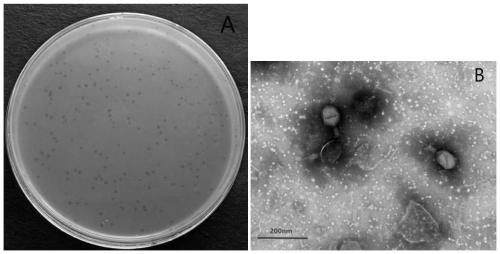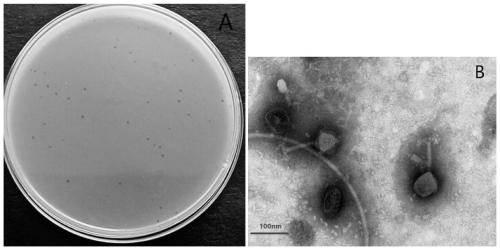Mixed preparation with bacteriophages LPEE17 and LPEK22 as major components and application
A bacteriophage and preparation technology, which is applied in the application field of controlling Escherichia coli O157:H7 and Salmonella in food, can solve the difficulty of improving food safety prevention and control, the development of drug resistance of food-borne pathogens, and the increase of food-borne pathogenic bacteria. The degree of harm of pathogenic bacteria to food safety, etc., to achieve the effect of good bacteriostatic effect
- Summary
- Abstract
- Description
- Claims
- Application Information
AI Technical Summary
Problems solved by technology
Method used
Image
Examples
Embodiment 1
[0022] Isolation and Preparation of Escherichia coli Phage
[0023] (1) Isolation of phage:
[0024] Water samples were taken from the Huazhong Agricultural University Hospital in Wuhan City, Hubei Province and Xianjian Village, Hongshan Street, Hongshan District, Wuhan City, Hubei Province. Two strains of Escherichia coli, Escherichia coli EDL933 and Escherichia coli KCJ4201, were used as host bacteria to isolate phage.
[0025] Centrifuge the water sample at 10,000×g for 10 minutes at 4°C, and perform preliminary filtration with filter paper to remove impurities with larger particles in the collected water sample; The supernatant was filtered again by the membrane, and the filtrate was the sample to be used to isolate the phage after the initial water sample was pretreated, and it was stored at 4°C. Inoculate the host bacteria in 5mL LB liquid medium, and culture it at 37°C to reach the logarithmic phase; take 5mL water sample, 2.5mL host bacteria liquid and 10mL LB medium...
Embodiment 2
[0031] Phage lysis profiling assay
[0032] In the experiment, coliphage LPEE17 and LPEK22 were selected for lysis profile determination on 34 strains of 30 strains of Escherichia coli and 4 strains of Salmonella.
[0033] Among them, 30 strains of Escherichia coli are:
[0034] 1) The 14 strains of Escherichia coli O157:H7 are: EDL933, KCJ4201, LEC12, LEC13, LEC14, LEC15, LEC16, LEC17, LEC18, LEC19, LEC20, LEC21, LEC25, LEC30;
[0035]2) The other 16 Escherichia coli strains are: Trans 10, DH5α, BL21(DE3), F18ac, c83715, E97, K12, D41, H10417, LEC22, LEC23, LEC24, LEC26, LEC27, LEC28, LEC29;
[0036] The 4 strains of Salmonella are:
[0037] 1) 2 strains of Salmonella Enteritidis ATCC 13076, SJTUF 10984;
[0038] 1) 2 strains of Salmonella typhimurium ATCC 14028, ATCC13311.
[0039] Cultivate the above-mentioned strains to the logarithmic phase respectively, take 100 μL of the bacterial solution cultured to the logarithmic phase and mix with 4mL 0.7% LA semi-solid medium,...
Embodiment 3
[0054] Phage Morphological Observation
[0055] (1) Morphology of phage on double layer agar plate
[0056] Phage LPEE17 and phage LPEK22 are potent phages, which form round, transparent plaques on the double-layer agar plate, whose shape is as follows: figure 1 Middle A and figure 2 Shown in A.
[0057] (2) Morphology of phage under transmission electron microscope
[0058] First, concentrate the phage, the specific steps are: Proliferate the phage in solid state, select a plate covered with plaques, scrape the upper layer of agar into 15 mL of LB liquid medium with a sterile cotton swab, 37°C, 200r / min Shake culture for 3h. After the incubation, centrifuge at 10000×g for 10 min at 4°C. Take the supernatant and filter it with a 0.22 μm filter membrane. Ultracentrifuge at 40,000r / min for 1h in a vacuum environment, discard the supernatant, add 500μL ammonium acetate solution, and obtain a titer ≥ 10 10 PFU / mL of phage stock solution. After preparing the high-titer pha...
PUM
 Login to View More
Login to View More Abstract
Description
Claims
Application Information
 Login to View More
Login to View More - Generate Ideas
- Intellectual Property
- Life Sciences
- Materials
- Tech Scout
- Unparalleled Data Quality
- Higher Quality Content
- 60% Fewer Hallucinations
Browse by: Latest US Patents, China's latest patents, Technical Efficacy Thesaurus, Application Domain, Technology Topic, Popular Technical Reports.
© 2025 PatSnap. All rights reserved.Legal|Privacy policy|Modern Slavery Act Transparency Statement|Sitemap|About US| Contact US: help@patsnap.com



